Hawaiian is a Polynesian language of the Austronesian language family that takes its name from Hawaiʻi, the largest island in the tropical North Pacific archipelago where it developed. Hawaiian, along with English, is an official language of the US state of Hawaii. King Kamehameha III established the first Hawaiian-language constitution in 1839 and 1840.
Huna is the word adopted by the non-Hawaiian New Age author Max Freedom Long (1890–1971) in 1936 to describe his theory of metaphysics. Long cited what he believed to be the spiritual practices of the ancient Hawaiian kahunas (priests) as inspiration; however, contemporary scholars consider the system to be his invention designed through a mixture of a variety of spiritual practices from various cultures, with roots in New Thought and Theosophy, rather than in traditional Hawaiian beliefs.
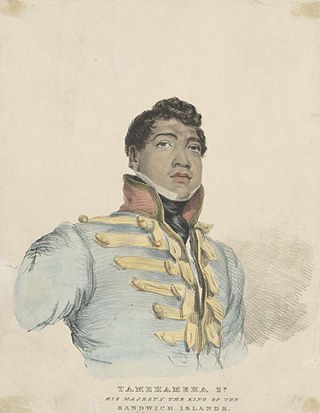
Kamehameha II was the second king of the Kingdom of Hawaii. His birth name was Liholiho and full name was Kalaninui kua Liholiho i ke kapu ʻIolani. It was lengthened to Kalani Kaleiʻaimoku o Kaiwikapu o Laʻamea i Kauikawekiu Ahilapalapa Kealiʻi Kauinamoku o Kahekili Kalaninui i Mamao ʻIolani i Ka Liholiho when he took the throne.
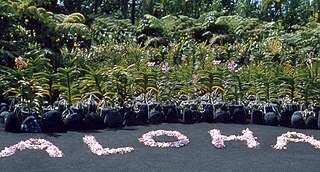
Aloha is the Hawaiian word for love, affection, peace, compassion and mercy, that is commonly used as a simple greeting but has a deeper cultural and spiritual significance to native Hawaiians, for whom the term is used to define a force that holds together existence.
The aliʻi were the traditional nobility of the Hawaiian islands. They were part of a hereditary line of rulers, the noho aliʻi.
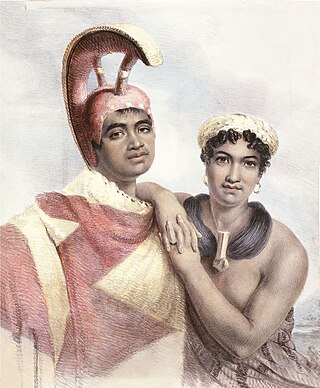
Kuini Liliha was a High Chiefess (aliʻi) and noblewoman who served the Kingdom of Hawaii as royal governor of Oʻahu island. She administered the island from 1829 to 1831 following the death of her husband Boki.

The Makahiki season is the ancient Hawaiian New Year festival, in honor of the god Lono of the Hawaiian religion.
A Hawaiian name is a name in the Hawaiian language. Such names are popular not only in Hawaiian families, but also among other residents of Hawaii, and even in the United States mainland among both non-native and native Hawaiians.

Miriam Auhea Kalani Kui Kawakiu o Kekāuluohi Kealiʻiuhiwaihanau o Kalani Makahonua Ahilapalapa Kai Wikapu o Kaleilei a Kalakua also known as Kaʻahumanu III, was Kuhina Nui of the Kingdom of Hawaii, a queen consort of both Kamehameha I and Kamehameha II, and mother of Lunalilo. In ʻŌlelo Hawaiʻi, Kekāuluohi means; "the vigorously growing vine". She adopted her secondary name Auhea, meaning Where, oh where, in memory of the death of Kamehameha I.
The phonological system of the Hawaiian language is based on documentation from those who developed the Hawaiian alphabet during the 1820s as well as scholarly research conducted by lexicographers and linguists from 1949 to present.

Hoʻoponopono is a traditional Hawaiian practice of reconciliation and forgiveness. The Hawaiian word translates into English simply as correction, with the synonyms manage or supervise. Similar forgiveness practices are performed on islands throughout the South Pacific, including Hawaii, Samoa, Tahiti and New Zealand. Traditional Hoʻoponopono is practiced by Indigenous Hawaiian healers, often within the extended family by a family member.

Metrosideros polymorpha, the ʻōhiʻa lehua, is a species of flowering evergreen tree in the myrtle family, Myrtaceae, that is endemic to the six largest islands of Hawaiʻi. It is a member of the diverse Metrosideros genus, which are widespread over the southwest Pacific. It is the state tree of Hawai‘i.
Lauhala, lau meaning "leaf" in the Hawaiian language, refers to the leaves of the hala tree (Pandanus tectorius).
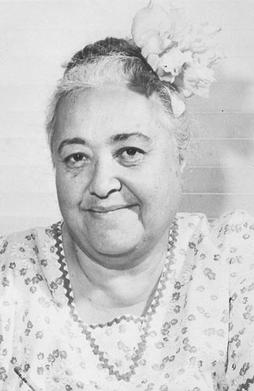
Mary Abigail Kawenaʻulaokalaniahiʻiakaikapoliopele Naleilehuaapele Wiggin Pukui, known as Kawena, was a Hawaiian scholar, author, composer, hula expert, and educator.
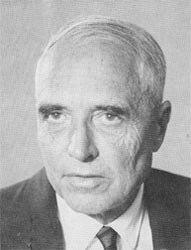
Samuel Hoyt Elbert was an American linguist who made major contributions to Hawaiian and Polynesian lexicography and ethnography. Born on a farm in Des Moines, Iowa, to Hugh and Ethelind Elbert, Sam grew up riding horses, one of his favorite pastimes well into retirement. After graduating from Grinnell College with an A.B. in 1928, he earned a certificate in French at the University of Toulouse and traveled in Europe before returning to New York City, where he waited tables, clerked for a newspaper, reviewed books, and studied journalism at Columbia University. Wanderlust took him to French Polynesia, first to Tahiti and then to the Marquesas, where he quickly became proficient in Marquesan. In 1936, he went to work for the United States Geological Survey in Hawaiʻi. There he met researchers on Pacific languages and cultures at the Bishop Museum, chief among them Mary Kawena Pukui, from whom he learned Hawaiian and with whom he worked closely over a span of forty years. When war broke out in the Pacific, the U.S. Navy employed him as an intelligence officer studying the languages of strategically important islands. He was posted to Samoa in 1943, then to Micronesia, where he collected and published wordlists for several island languages.

Lorrin Andrews was an early American missionary to Hawaii and judge. He opened the first post-secondary school for Hawaiians called Lahainaluna Seminary, prepared a Hawaiian dictionary and several works on the literature and antiquities of the Hawaiians. His students published the first newspaper, and were involved in the first case of counterfeiting currency in Hawaii. He later served as a judge and became a member of Hawaii's first Supreme Court.
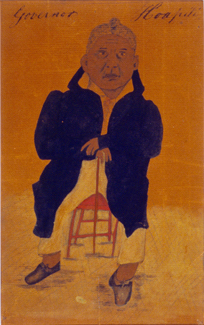
Ulumāheihei Hoapili was a member of the nobility during the formation of the Kingdom of Hawaii. He was a trusted military and political advisor to King Kamehameha I, known as "Kamehameha the Great". Although trusted with one of the last symbolic rites of the Hawaiian religion, he later became a supporter of Christian missionaries.

ʻEwa was one of the original districts, known as moku, of the island of Oʻahu in Ancient Hawaii history.
Mele Kaʻauʻamokuokamānele or Kamānele was a high chiefess of the Kingdom of Hawaii and the betrothed bride of King Kamehameha III. Her early death prevented the marriage from occurring. Her Hawaiian name Kamānele means "the sedan chair".
Esther Takakura Mookini is an American linguist responsible for several widely used Hawaiian-language dictionaries.











